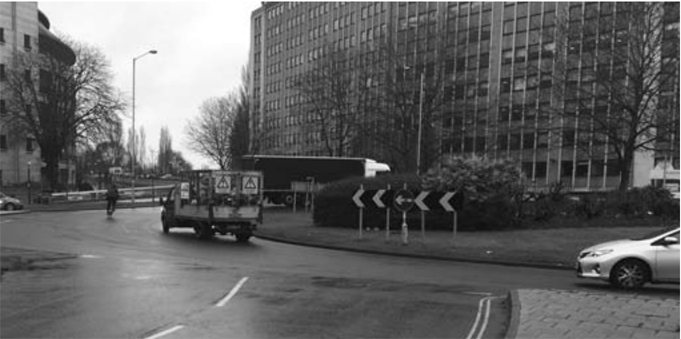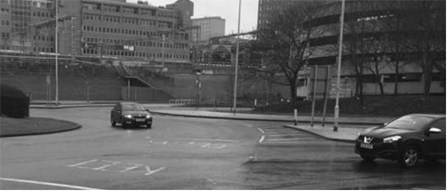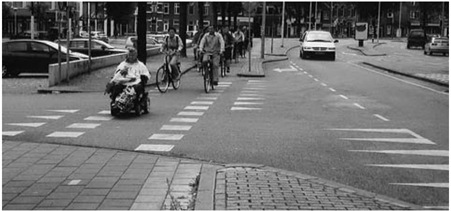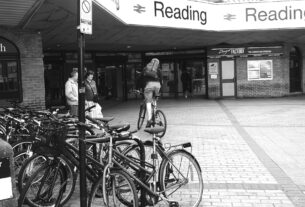
The Vastern Road roundabout by Reading Bridge is by far the most dangerous area for cyclists in Reading.
The official collision records (STATS19) show 19 cyclist casualties in three years. These atrocious figures should be generating urgent action by Reading Borough Council. Unfortunately, four months after the issue being raised RCC have seen no remedial proposals, nor repainting of the worn road markings.

Most of the collisions appear to be failure to give way by motorists entering the roundabout and hitting a cyclist. Eight of these being northbound cyclists hit by vehicles exiting Vastern Road, three with cyclists exiting Vastern Road, and three with southbound cyclists hit by vehicles exiting Napier Road.
Five arm junctions like this tend to have a poor safety record, whether they are roundabout or signal controlled. The number and complexity of vehicle movements is probably a factor, with users less able to judge the intended route of others even if they are signalling.
There are a number of problems that make conditions difficult and dangerous for cyclists at this junction. They were noted by RCC at the time of construction, more than three years ago, and have been reiterated in recent months.
We see the problems as:
- The large carriageway widths and no circular lane markings encourage higher speeds than appropriate and poor lane discipline. The layout also encourages unsafe overtaking on the roundabout. The deflections of traffic feeding onto the roundabout are mainly inadequate to slow traffic and not to Department for Transport design standards.
- The current three lane approach from Vastern Road is made worse by the offside bus lane on the approach and the nearside lane changing from straight ahead to turn left, forcing most traffic into one lane from two, causing potentially dangerous lane swapping on the approach. This is a possible distraction from watching for vehicles and particularly cyclists on the roundabout.
- The two southbound lanes over Reading Bridge have generally caused problems with encouraging injudicious overtaking and use of the wrong lane, both of which can lead to knock-on problems at the roundabout.
- The two or three (unmarked) lanes that reduce to one narrow lane on the bridge approach are dangerous and do not conform to roundabout design standards.
- Cyclists have difficulty moving from the bus lane under the railway into the traffic lane for Vastern Road or Reading Bridge. Give-way markings on the Vastern Road approach in particular are now worn, making them less effective. The greater carriageway widths have also made conditions worse for pedestrians, particularly on the Reading Bridge arm.
Solutions or at least improvements to the junction should include:
- Provide some form of spiral lane markings on the circulatory sections. This may necessitate separating the northbound vehicle lanes for Vastern Road and Reading Bridge with lane markings under the railway bridge and in Forbury Road.
- Remove unnecessary carriageway space with hatch markings and/or preferably kerb build-outs.
- Reduce Napier Road exit from two lanes to one.
- Review the alignment of the car park entry and exits.
- Ensure that give-way and other markings are re-marked to maintain visibility.
- Consider partial signalisation of the roundabout with pre-signals for cyclists.
The current authorised give-way markings for a roundabout are a single dashed line as opposed to a much wider dashed line on mini-roundabouts and a double dashed line at give-way junctions.

A bolder give-way line is required at conventional roundabouts particularly large ones as at Vastern Road. What is really needed are the ‘shark’s tooth’ markings (see right) which are far more conspicuous and are almost universally used in other European countries. This would then replace the current three different types of give-way marking.
Will Reading try and agree a trial scheme with the Department for Transport?
John Lee, RBC Campaigner for RCC




I’ve noticed all the problems that are mentioned in this very well researched and presented article, when negotiating this roundabout. Far from improving the roundabout the Council is proposing to shave the radius between Napier Road and the south bound arm beneath the bridge to provide and additional bus lane for the new buses that the council plans to run along the East Reading MRT. I have asked the council how this is supposed to make the roundabout safer for cyclists. The additional complexity, and bus traffic is only likely to make it more dangerous.
Very interesting, but how do I fact check or read more? It would be really helpful if the article provided links were possible.
For example, you talk about roundabout design standards, but there’s no link. Do you mean this document? http://www.standardsforhighways.co.uk/ha/standards/dmrb/vol6/section2/td1607.pdf
Similar for the two southbound lanes that have caused problems – are those problems reported on a news site or something?
I realise I have loads of non-critical questions, and it would be a disaster if your succinct and easy-to-read post turned into verbal diarrhoea, but I do think some links would help.
Yes the DMRB is the official DfT guidance and standards, with volume 6 section 2 dealing with roundabouts. There are other guidance documents that can assist, particularly for smaller urban roundabouts.
scares the proverbial out of me, but the half mile detour over the cycle bridge helps!
The worst part for me is the traffic entering the roundabout from Caversham. When traffic is light there is almost no slow-down, as the article says there is minimal deflection and cars just don’t slow down, giving them less time to look for cyclists until it’s too late. Happened to me twice, I ride across London to get to work and have never been as close to death as I have on this roundabout.